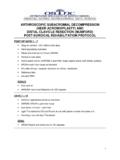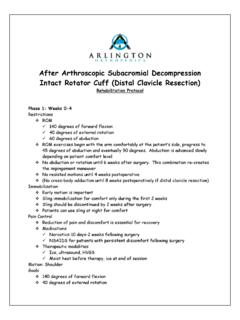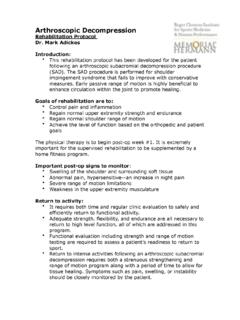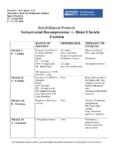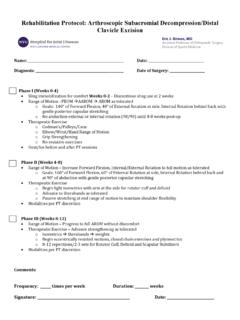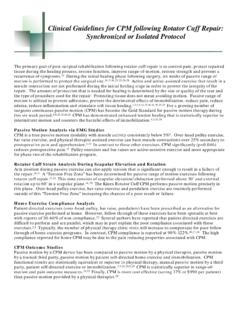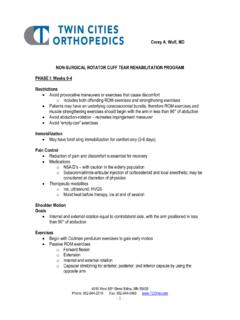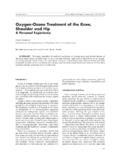Transcription of Subacromial Decompression Protocol - South …
1 South Shore Hospital Orthopedic, Spine and Sports Therapy in Clinical Collaboration with South Shore Orthopedics Page 1 Subacromial Decompression Protocol Anatomy and Biomechanics The shoulder is a wonderfully complex joint that is made up of the ball and socket connection between the humerus (ball) and the glenoid portion of the scapula (socket). The socket portion of the joint is not naturally deep. For this reason, the shoulder is the most mobile joint in the body. Due to the lack of boney coverage the shoulder s proper function and stability is largely dependent on the soft tissues that surround it.
2 The shoulder joint is extremely important when the arm is used during activities that involve lifting, pushing and pulling, but especially when the arm is repetitively placed overhead. Over time with continual repetitive activity the soft tissues and joint surfaces of the shoulder are subject to wear and tear and degeneration. The soft tissue around the joint can become irritated and inflamed and excess bone (spurs) can form as a result. These inflammatory or degenerative changes often leave the shoulder feeling achy and sore during everyday activities. Treatment Options Regardless of nature or extent of the degeneration in the shoulder your physician will work with you to determine what the best course of treatment will be.
3 In many cases the pain and dysfunction associated with degenerative changes can be successfully treated with rest, anti-inflammatory measures, activity modification and Physical Therapy. When these conservative measures are unsuccessful in restoring function your physician may recommend that you undergo arthroscopic surgery to remove the irritated, degenerative tissue in the shoulder. South Shore Hospital Orthopedic, Spine and Sports Therapy in Clinical Collaboration with South Shore Orthopedics Page 2 Surgery The Subacromial Decompression procedure involves removing tissue from the front part of the shoulder.
4 This part of the shoulder is referred to as the Subacromial space, as it is located below the outcropping of bone on the scapula (shoulder blade) know as the acromian process. During the procedure the end of the acromian process and any inflamed tissue including the Subacromial bursa is debrided. This creates more room in the front of the shoulder so that the tendons of the rotator cuff can move freely without getting irritated or pinched. The procedure is performed arthroscopically and is, in most cases an outpatient day surgery. This means that it is very rare to have to spend the night in the hospital.
5 Recovery/Time off Work Before undergoing Subacromial Decompression surgery your doctor will discuss the recovery process with you. It is very important that the patient knows that the recovery process is fairly difficult and time consuming. He or she must be an active participant during this process, performing daily exercises to ensure there is proper return of the shoulder s range of motion and strength. There is a large amount of variability in the time it takes to fully recover from this procedure and is typically dependant on the extent of the damage that needs to be fixed. It is usually estimated that it will take at least 3-4 months to feel as though you have completely regained the use of your arm.
6 Some cases may take as long as 6-9 months to make a full recovery. People with desk jobs should plan to take at least 1 week off from work. Those with jobs that require physical activity and lifting will likely be out of work for at least 3 months. Recovery is different in each case. Your individual time table for return to activities and work will be discussed by your surgeon during post operative office visits. Post Operative Visits Your first post-op visit to the doctor s office will be approximately 7-10 days after the operation. At this visit any stitches you have will be removed and you will review the surgery with the doctor or his assistant.
7 At this time you will most likely be cleared to make an appointment to begin Physical Therapy. You should also plan to check in with your surgeon at 6 and 12 weeks after the operation. The surgeon may create a different timetable for postoperative office visits if your case warrants it. At Home You may remove your post-op dressing 2 days after the operation and replace it as needed. Do not remove the tape (steri-strips) that is across your incisions. Allow them to fall off on their own. You may shower after 2 days, but use a water-tight dressing until your sutures are removed. Bathing without getting the shoulder wet or sponge baths are a good alternative.
8 You may wash under the affected arm by leaning forward and letting the arm dangle. You may move your arm in front of your body, but not South Shore Hospital Orthopedic, Spine and Sports Therapy in Clinical Collaboration with South Shore Orthopedics Page 3 out to the side until your doctor allows you. You may remove your sling several times a day and gently move your hand, wrist and elbow and perform shoulder pendulum exercises. Medication Your surgeon will prescribe pain medicine for you after the operation. Please call the doctor s office if you have any questions regarding medication. Ice You must use ice on your shoulder after the operation for management of pain and swelling.
9 Ice should be applied 3-5 times a day for 10-20 minutes at a time until the postoperative inflammation has resolved. Always maintain one layer between ice and the skin. Putting a pillow case over your ice pack works well for this. Sling You will be provided with a sling to wear after the operation. Remove it when bathing/showering, or to do your exercises. You should remove the sling several times a day to perform pendulum exercises as instructed. Wear the sling most of the time (especially when out in public) until you see your doctor for your first post op visit. Most patients use their sling for about 2 weeks.
10 If your case is atypical your doctor may have custom guidelines for you regarding use of the sling. Sleeping You may sleep with a pillow propped under your arm to keep it slightly away from the body if you need to. For many patients lying flat is uncomfortable at first. It is generally easier to sleep propped up for a short period of time after the operation. Do not attempt to sleep on your operated shoulder for at least 6 weeks. South Shore Hospital Orthopedic, Spine and Sports Therapy in Clinical Collaboration with South Shore Orthopedics Page 4 Rehabilitation **The following is an outlined progression for rehab.

